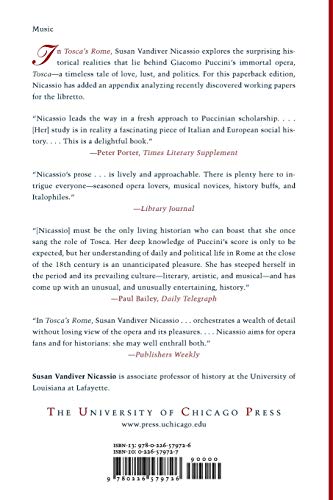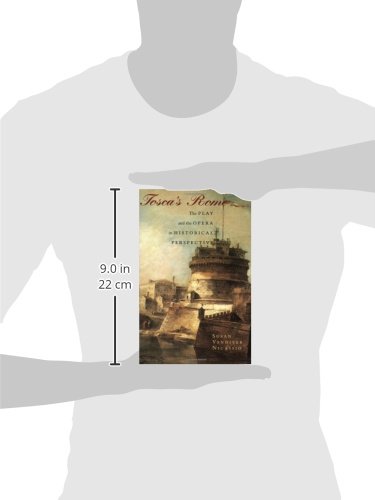معلومات عنا
دعم العملاء
احصل على التطبيق

قم بتوجيه الكاميرا لتنزيل التطبيق
حقوق الطبع والنشر © 2024 Desertcart Holdings Limited




Tosca's Rome: The Play and the Opera in Historical Perspective
P**G
Tosca, Puccini and Revolutionary Rome
This book is a sumptious confection for either the opera-lover or the historian, since it can be read from either viewpoint. Susan Vandiver Nicassio has wrirren a rarity, a backgrounder on one of the world's famous operas that does not simply bog down in retelling the story as so many do.After a Preface that should on no account be overlooked, Nicassio divides the book into two halves, a social history and a musical analysis. Tosca is rare among operas in being set in a specific historic time and place: Rome during the few months between the fall of the ramshackle Roman Republic of 1798-99 and the return of Pope Pius VII, a brief interval during which Rome was occupied and ruled by the Bourbon royal family of Naples. Sketching the situation in Rome at the time and the damage inflicted on the city by the Republicans and their French tutors, she goes on to examine the contemporary scene in chapters giving the viewpoint of its three main characters: an artist, a musician, and a policeman. The result is in many ways more enlightening than a mere straight history. The second part of the book is a more orthodox musical analysis of the opera by themes, motives and motivations, but even here her dramatic analysis persistently strays back to material laid down in the first half.One of Nicassio's intriguing ideas is that Puccini in fact turned the historical situation on its head to serve his own political and philosophical agenda, something of which many opera composers have been guilty. The papal government that Puccini blames for the deaths of his hero and heroine was actually, she notes, an amiably inefficient structure that had doddered along for decades, rarely killing anybody for anything -- in fact, in less than two years the French-sponsored Republic carried out more executions than the Papacy had in the entire previous century. Americans tend to associate Scarpia in their minds with the dreaded Inquisition, but in fact the Roman Inquisition had never been nearly as cruel as that of Spain, and in any case by 1798 was a ghostly shell of itself. But Puccini (and the French author Sardou, who wrote the overheated and long-winded play on which Puccini based his opera) were writing a century later, at a time when the Popes were "prisoners of the Vatican," secluding themselves in that structure and refusing to recognize the existence of the Kingdom of Italy. Both the playwright and the composer were fiercely anti-religious and (although Puccini had to keep it discreet) republican, so they depicted their protagonists as caught in the toils of a fiendish papal government that never existed, rather than admit that the true persecutors and executioners of the time had been the Roman Republic that they both worshipped. The result is an immortal opera, but one that is founded on myths and ideology rather than historical fact.
A**R
Great Read! Vandiver-Nicassio does an excellent job telling the ...
Great Read! Vandiver-Nicassio does an excellent job telling the history of the play and opera. A little help for those not up to speed on operas would have helped.
O**A
Five Stars
Thank you so much
D**S
Great information !
Thoroughly researched, but entertaining background comparing historical events, the Sardou play written for Bernhardt, and the opera. A must-have for Puccini fans.
M**L
Five Stars
This is not a dry, academic , history. This boiok works on many different levels, history music etc.
R**A
For me, a disappointment
TOSCA'S ROME The Play and the Opera in Historical Perspectiveby Susan Vandiver Nicassio Can you believe it? There are TWO full length books written about the semi fictitious Tosca! As far as I know, not even Shakespeare can claim that distinction (of course, there's plenty written about his historical characters, but to my knowledge, no books about his fictitious ones). That being said, in order to appreciate this book the reader must be a Puccini scholar, a specialized history buff (namely, Roman history between 1790-1810), or obsessed with Tosca. The latter category isn't as far-fetched as it may sound. I've personally known several people who, upon first hearing, were so immersed in the heady melodrama they instantly became Tosca fanatics and memorized the entire opera from first note to last. When I first saw Tosca forty years ago, I was spellbound and set to translating the five act play into English. No small accomplishment for a fourth year French student. When asked to illustrate a libretto for the Santa Fe Opera, my first response was to illustrate Tosca, but soon realized that Tosca works best for the huge, open spaces of an opera house so I opted for the more intimate Madama Butterfly The Fully Illustrated Libretto of Puccini's Madama Butterfly followed by The Fully Illustrated Libretto of Ravel's L'Enfant et Les Sortileges (Librettos) and recently, The Fully Illustrated Libretto of Gian Carlo Menotti's the Medium More than likely I would have loved this book on Tosca back when I was translating the play, but I now find this book rather tedious as Ms. Nicassio fills it with what for me are endless, superflous details. Does anyone care, for example, that Cavaradossi and Angelotti could not have left San Andrea from a side door because such a door doesn't exist? Although the author wrote intelligently, her style is wordy. I frequently found myself rereading a sentence several times for by the time I got to its end I had forgotten how the sentence started. All in all, a well researched book, but for anyone interested in this period, one might better consider a broader treatment of the Napoleonic era.
N**R
A Must For Opera Buffs
Actually, this scholarly but lively book is about much more than Tosca. Theauthor goes into great detail about Roman life at the time of the opera'saction--the religious structures, law enforcement, art, music, and so on.Only then comes a detailed study of the opera, with plenty of references toSardou's play, especially where plot action was compressed, so one learnssomething on a rare subject, the adaptation of plays into music dramas--which,after all, was the business model for nineteenth-century and earlytwentieth-century opera. Even the most knowledgeable Tosca fan will learn agreat deal about this fascinating piece, and the book climaxes verysatisfactorily with a long sequence considering exactly why the work endswith the "wrong" music. A great read.
W**L
Excellent
Book exceeded expectations and was very promptly dispatched. Well satisfied.
C**S
Love this book read in conjunction with Piers Paul Read's ...
Love this book read in conjunction with Piers Paul Read's novel "Scarpia" brings several new dimensions to one of my all time favourite operas.
M**E
Five Stars
Book interesting
ترست بايلوت
منذ 3 أسابيع
منذ شهر